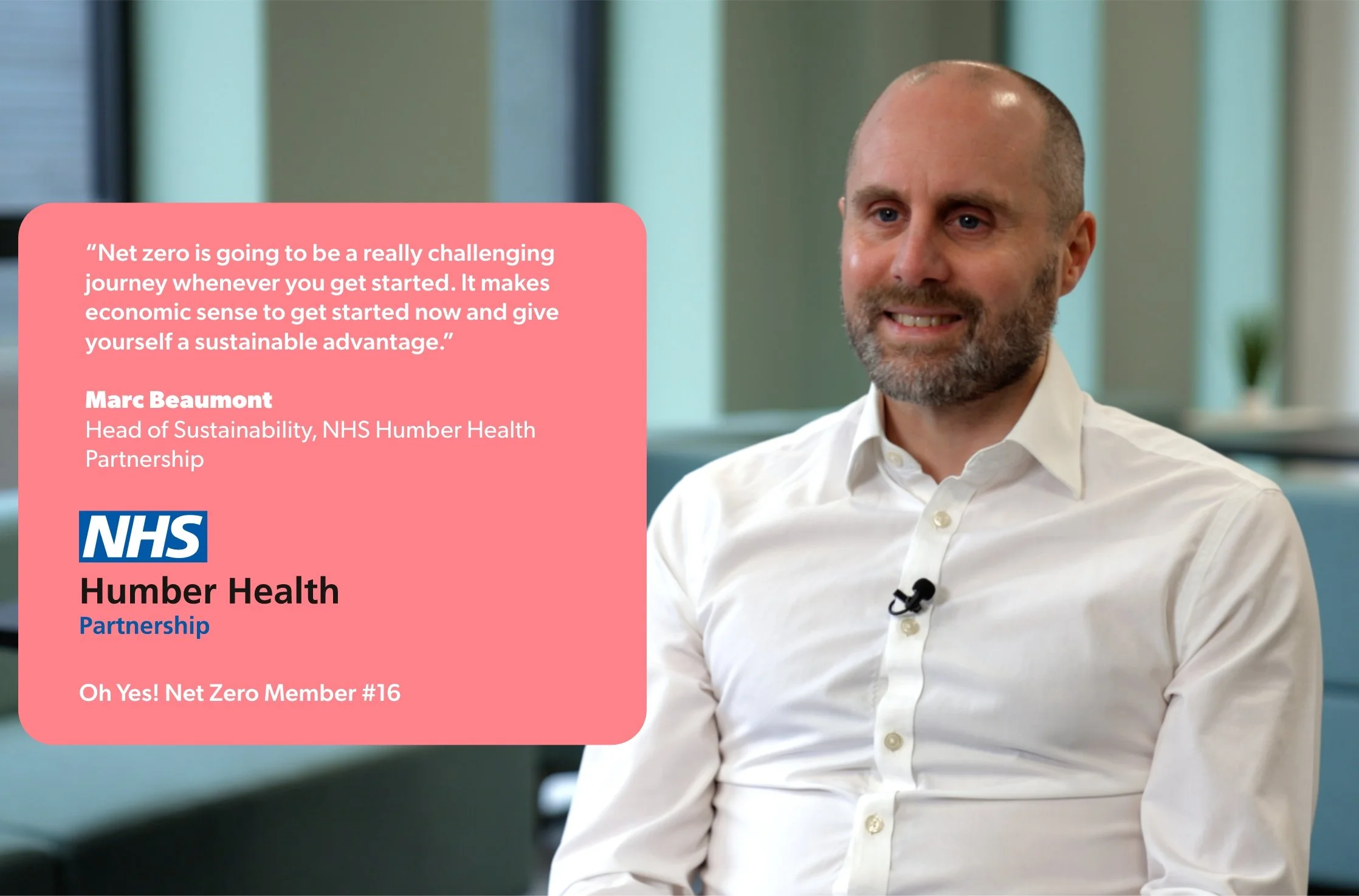Smith+Nephew x NHS
Why your supply chain is key when setting net zero targets
In 2019, the UK Government committed to reducing the UK’s net greenhouse gas emissions by at least 100% by 2050, compared to 1990 levels. This is known as net zero.
Every organisation needs to think about reducing its carbon footprint. Knowing what targets to set, however, can be challenging.
Creating a net zero strategy must be done with your supply chain in mind. It might be that you need to act more quickly to continue working with companies in the future.
The NHS has announced that, from 2027, 80,000 suppliers spanning all sectors will be required to publicly report emissions and publish a Carbon Reduction Plan for Scope 1, 2 and 3 emissions.
We spoke to representatives of two Oh Yes! Net Zero members – Marc Beaumont, Head of Sustainability at the NHS Humber Health Partnership, and Paul Andrews, Director of Global Energy, Smith+Nephew – to hear their net zero stories so far.
A range of Smith & Nephew products, ALLEVYN◊ Wound Dressings, OneNPWT, R3◊ Acetabular System.
‘Net zero was seen as a cost pressure … there is evidence now to show it makes good business sense’
As Head of Sustainability at the NHS Humber Health Partnership, Marc Beaumont is acutely aware of the scale of the challenge ahead.
“The NHS has a huge impact on the environment as a provider of healthcare services,” Marc explained.
“It accounts for around five per cent of carbon emissions in the UK. Reasons for that range from transport and the services the NHS delivers, to the running of its estates.”
But change is afoot. Hull’s hospitals received £12.6m of grant funding, as part of the Government’s Public Sector Decarbonisation Scheme, and has embarked on a transformative carbon reduction programme.
“Net zero was once seen as a cost pressure and an expense for organisations – but there is enough evidence now that it makes good business sense,” Marc said
“For us, a lot of the investments we are making are spend-to-save projects. Renewable energy has saved us £1m a year, from the solar farm alone, and the payback time on that project is around four years.”
Marc Beaumont
Head of Sustainability, NHS Humber Health Partnership
The headline investment from the funding is a 5MW solar farm which sits on land adjacent to Cottingham’s Castle Hill Hospital. It means the hospital site can now be fully powered by solar energy at peak generation times during the daytime through summer months.
The funding has also enabled the Trust to replace gas boilers with heat pumps and improve insulation across its estate.
“Net zero was once seen as a cost pressure and an expense for organisations – but there is enough evidence now that it makes good business sense,” Marc said.
“For us, a lot of the investments we are making are spend-to-save projects. Renewable energy has saved us £1m a year, from the solar farm alone, and the payback time on that project is around four years.
“We have also reduced the use of gas and air – used in anaesthesia – across the Trust by 80 per cent. That alone has saved us around £40,000 a year.”
Video Case Study
Engaging with your supply chain is crucial in the transition to net zero. Here, the NHS Humber Health Partnership’s Marc Beaumont and Smith+Nephew’s Paul Andrews discuss how the two organisations are working together to reduce their carbon footprint.
‘Don’t simply see net zero as 2050 – you may have to act sooner’
Medical equipment manufacturer Smith+Nephew’s story began 170 years ago, in Hull.
As an important supplier of medical devices to the UK’s public health service, Smith+Nephew made the decision to align its net zero target with the NHS.
Paul Andrews, Director of Global Energy at Smith+Nephew, explained: “We have a long history of working with the NHS, and took a strategic decision as a company to align our own net zero ambition.
“Our target is to be net zero for Scope 1 and 2 by 2040, and Scope 3 for 2045. We have a number of stakeholders, including the NHS, asking us to report our carbon emissions and measure those around the world.”
From April 2027, NHS suppliers – regardless of what product or service they supply - will be required to publicly report targets, emissions and publish a Carbon Reduction Plan for global emissions.
For businesses without a plan in place, it requires a significant acceleration of their approach to net zero, to ensure they remain compliant with organisations in their supply chain.
‘Dive in and have a go – you won’t get everything right, but you learn’
Every organisation will face its own unique challenges in reducing their carbon footprint.
For Smith+Nephew, measuring and improving the energy efficiency of its estate was identified as a priority.
“We have a fairly old site in Hull, so our first step was to look at reducing existing emissions across our estate,” Paul said.
“There are some simple steps you can take, whether that’s using less energy, installing LED lighting, or looking at building management systems to turn things off when not in use.
“We also plan to install solar panels at our site in Hull, to generate our own electricity. Buying green energy is important and we have increased our proportion of renewable tariffs wherever possible.”
The NHS accounts for around five per cent of UK carbon emissions.
Smith+Nephew is also investing £94m in a new site at Melton West business park, west of Hull.
The new facility has been designed to high sustainability standards, with a focus on energy and resource efficiency. Solar panels will be installed and green energy schemes are being examined to decarbonise and move away from gas.
Paul added: “It’s easy to look at net zero as an added cost, but it can drive savings.
“If you use less energy, you will spend less on it. Our experience is self-generation through solar will create savings, and the payback time is strong at the moment.
“If you use less energy, you will spend less on it. Our experience is self-generation through solar will create savings, and the payback time is strong at the moment.
“Our approach is to dive in and have a go. Each time you do something, you learn more and get more information and data to go forwards with.”
‘Get started with net zero and give yourself a sustainable advantage’
For the NHS, the task of consulting with its 80,000 suppliers to support them with net zero is no small task.
Marc Beaumont said: “Our experience has been that larger suppliers tend to have a greater depth of knowledge on net zero. They may have a dedicated sustainability lead, or already have a plan in place.
“For SMEs, it can be really difficult. Time can be hard to find and they may not have the knowledge in-house.
“Net zero is going to be a really challenging journey whenever you get started. It makes economic sense to get started now and give yourself a sustainable advantage.”
If you are an organisation yet to embark on net zero, exploring your supply chain’s own targets may help you create a realistic plan and maintain important relationships.
For the latest news from Oh Yes! Net Zero, visit www.ohyesnetzero.uk/news/











